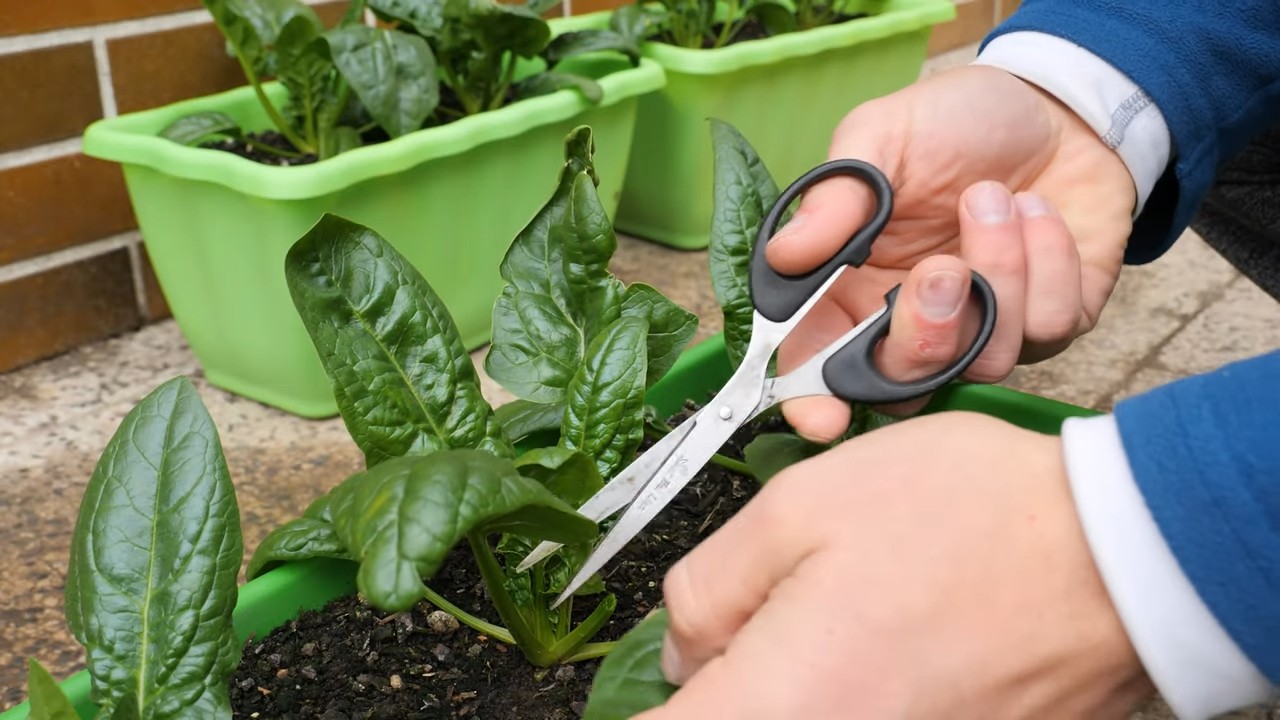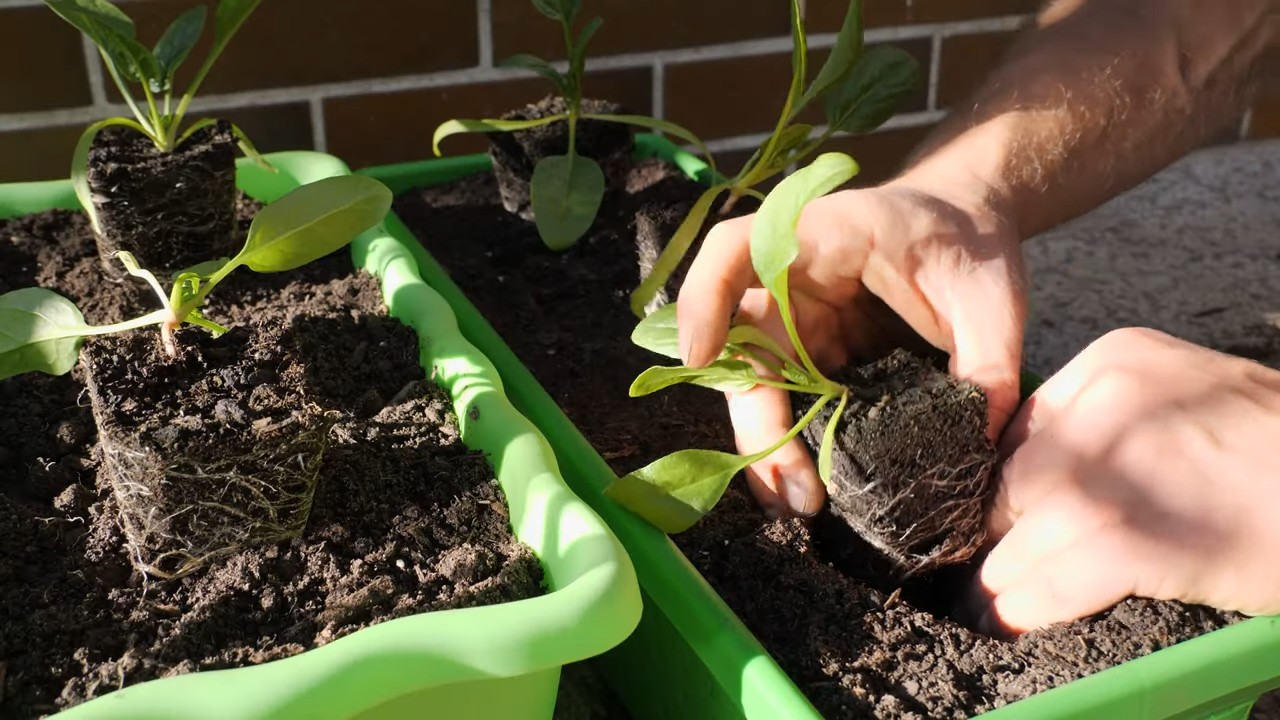Grow Spinach Quickly and unlock the secrets to a thriving, leafy green harvest right in your own backyard! Have you ever dreamt of effortlessly plucking fresh, vibrant spinach leaves for your salads, smoothies, or savory dishes? I know I have! For centuries, spinach has been a culinary staple, dating back to ancient Persia where it was prized for its nutritional value and versatility. From there, it journeyed across continents, becoming a beloved ingredient in countless cuisines.
But let’s face it, sometimes getting spinach to flourish can feel like a battle against the elements and unpredictable growing conditions. That’s where these DIY tricks and hacks come in! I’m going to share some simple yet effective methods to help you grow spinach quickly, even if you’re a beginner gardener. Imagine the satisfaction of bypassing the grocery store and harvesting your own organic, nutrient-packed spinach whenever you desire.
This article is your guide to transforming your garden into a spinach-producing powerhouse. We’ll cover everything from soil preparation and seed selection to watering techniques and pest control, ensuring you have all the knowledge you need to enjoy a bountiful spinach harvest in no time. So, grab your gardening gloves, and let’s get started!

Grow Spinach Quickly: My Foolproof DIY Guide
Hey there, fellow garden enthusiasts! I’m so excited to share my secrets for growing spinach quickly and abundantly. Forget waiting ages for those tender, leafy greens – with my method, you’ll be harvesting in no time! I’ve perfected this over the years, and I’m confident you can achieve similar success. Let’s dive in!
Choosing the Right Spinach Variety
First things first, not all spinach is created equal when it comes to speed. Some varieties are naturally faster growers than others. Here’s what I recommend:
* ‘Baby’ Spinach Varieties: These are bred for quick growth and tender leaves. Think ‘Baby’s Leaf Hybrid’ or ‘Space’. They’re my go-to for a speedy harvest.
* Smooth-Leaf Varieties: Generally, smooth-leaf spinach tends to mature faster than savoy (crinkled) leaf types. ‘Tyee’ is a great option.
* Consider Bolt Resistance: Especially if you’re gardening in warmer weather, choose a bolt-resistant variety like ‘Malabar’ or ‘New Zealand’ spinach (though technically not true spinach, they taste similar and thrive in heat). Bolting means the plant prematurely goes to seed, making the leaves bitter.
Preparing Your Spinach Bed: The Foundation for Success
Proper soil preparation is absolutely crucial for rapid spinach growth. Spinach needs nutrient-rich, well-draining soil. Here’s how I get mine ready:
* Sunlight: Spinach loves sunshine, but it can tolerate partial shade, especially in hotter climates. Aim for at least 4-6 hours of direct sunlight per day.
* Soil Testing (Optional but Recommended): A soil test will tell you the pH and nutrient levels of your soil. Spinach prefers a slightly acidic to neutral pH (around 6.5 to 7.0). You can buy a soil testing kit at most garden centers.
* Amending the Soil: This is where the magic happens! I like to amend my soil with plenty of organic matter. Here’s my recipe:
* Compost: This is my secret weapon! Compost adds nutrients, improves drainage, and helps retain moisture. I use about 2-3 inches of compost worked into the top 6-8 inches of soil.
* Well-Rotted Manure: Another fantastic soil amendment. Just make sure it’s well-rotted to avoid burning the plants. I use about 1-2 inches.
* All-Purpose Organic Fertilizer: I sprinkle in a balanced organic fertilizer (like a 5-5-5 or 10-10-10) according to the package directions. This gives the spinach a boost of essential nutrients.
* Tilling or Turning the Soil: Use a garden fork or tiller to thoroughly mix the amendments into the soil. This creates a loose, well-aerated bed that’s perfect for spinach roots.
* Raking Smooth: Rake the soil smooth to create a level planting surface.
Sowing Spinach Seeds: Getting Started Right
Now for the fun part – planting the seeds! Here’s my method for ensuring good germination and healthy seedlings:
* Timing is Key: Spinach is a cool-season crop, meaning it thrives in cooler temperatures. I plant my spinach in early spring (as soon as the soil can be worked) or in late summer/early fall for a fall harvest. Avoid planting during the heat of summer, as spinach tends to bolt in hot weather.
* Direct Sowing: Spinach is best direct-sown, meaning you plant the seeds directly into the garden bed. It doesn’t transplant well.
* Seed Depth: Plant the seeds about ½ inch deep. I use my finger to make small furrows in the soil, then sprinkle the seeds in.
* Spacing: Space the seeds about 1-2 inches apart in rows that are 12-18 inches apart. You can always thin the seedlings later if they’re too crowded.
* Watering: Gently water the soil after planting. Keep the soil consistently moist but not waterlogged until the seeds germinate.
* Marking the Rows: I always mark my rows with plant labels so I know what I’ve planted.
Nurturing Your Spinach: Keeping it Happy and Healthy
Once your spinach seedlings emerge, it’s important to provide them with the right care to ensure rapid growth.
* Watering: Spinach needs consistent moisture to thrive. Water deeply whenever the top inch of soil feels dry. Avoid overhead watering, as this can promote fungal diseases. I prefer using a soaker hose or drip irrigation.
* Thinning: Once the seedlings are a few inches tall, thin them to about 3-4 inches apart. This gives them enough room to grow and prevents overcrowding. You can eat the thinnings!
* Weeding: Keep the spinach bed free of weeds. Weeds compete with spinach for nutrients and water. I like to hand-weed regularly.
* Fertilizing: Spinach is a heavy feeder, so it benefits from regular fertilization. I side-dress my spinach with a balanced organic fertilizer every 2-3 weeks. You can also use a liquid fertilizer, such as fish emulsion or seaweed extract.
* Pest Control: Keep an eye out for pests like aphids, slugs, and leaf miners. Here’s how I deal with them:
* Aphids: I blast them off with a strong stream of water from the hose. You can also use insecticidal soap.
* Slugs: I use beer traps or diatomaceous earth to control slugs.
* Leaf Miners: I cover my spinach with row covers to prevent leaf miners from laying their eggs.
* Bolting Prevention: As I mentioned earlier, bolting is a common problem with spinach, especially in hot weather. Here are some tips to prevent bolting:
* Choose Bolt-Resistant Varieties: This is the most important step.
* Provide Shade: In hot weather, provide shade for your spinach with shade cloth or by planting it in a partially shaded area.
* Water Regularly: Consistent moisture helps prevent bolting.
* Harvest Regularly: Harvesting the outer leaves encourages the plant to produce more leaves and delays bolting.
Harvesting Your Spinach: The Fruits (or Leaves!) of Your Labor
The best part! You can start harvesting spinach leaves as soon as they’re big enough to eat, usually about 4-6 weeks after planting.
* Harvesting Method: I prefer to harvest the outer leaves first, leaving the inner leaves to continue growing. This is called “cut-and-come-again” harvesting. You can also harvest the entire plant at once.
* Harvesting Time: Harvest spinach in the morning, when the leaves are crisp and cool.
* Storage: Store spinach in the refrigerator in a plastic bag or container. It will keep for several days.
Troubleshooting: Common Spinach Problems and Solutions
Even with the best care, you might encounter some problems while growing spinach. Here are some common issues and how I deal with them:
* Poor Germination: If your spinach seeds aren’t germinating, it could be due to several factors:
* Old Seeds: Spinach seeds lose their viability quickly. Use fresh seeds.
* Soil Temperature: Spinach seeds germinate best in cool soil (around 50-65°F).
* Moisture: The soil needs to be consistently moist for germination.
* Yellowing Leaves: Yellowing leaves can indicate a nutrient deficiency, overwatering, or disease.
* Nutrient Deficiency: Fertilize with a balanced organic fertilizer.
* Overwatering: Make sure the soil is well-draining and avoid overwatering.
* Disease: Check for signs of disease and treat accordingly.
* Bolting: As mentioned earlier, bolting is a common problem in hot weather. Follow the tips above to prevent bolting.
* Pest Infestations: Regularly inspect your spinach plants for pests and treat them promptly.
Extra Tips for Super Speedy Spinach Growth
Here are a few extra tricks I’ve learned over the years to really boost spinach growth:
* Soak Seeds Before Planting: Soaking spinach seeds in water for 24 hours before planting can improve germination rates.
* Use Row Covers: Row covers protect spinach from pests and diseases, and they also help to warm the soil in early spring.
* Succession Planting: Plant spinach seeds every 2-3 weeks for a continuous harvest throughout the growing season.
* Companion Planting: Plant spinach with companion plants like radishes, lettuce, and onions. These plants can help to deter pests and improve soil health.
My Favorite Spinach Recipes
Now that you’re growing your own delicious spinach, here are a few of my favorite ways to use it:

Conclusion
So, there you have it! Mastering the art of how to grow spinach quickly is not only achievable but also incredibly rewarding. Forget those wilted, overpriced bags of spinach from the grocery store. Imagine stepping into your garden and harvesting vibrant, crisp, and nutrient-packed spinach leaves whenever you desire. This DIY trick empowers you to do just that, offering a sustainable and cost-effective way to enjoy this leafy green.
But why is this method a must-try? It’s simple: speed, efficiency, and control. Traditional spinach growing can be a slow and sometimes frustrating process, especially if you’re battling unpredictable weather or poor soil conditions. Our method, focusing on [mention specific techniques from the article, e.g., seed starting indoors, proper soil preparation, and strategic watering], significantly accelerates the growth cycle, allowing you to harvest your first batch of spinach much sooner than you thought possible.
Beyond the speed, this DIY approach gives you complete control over the growing environment. You can tailor the soil composition, light exposure, and watering schedule to create the ideal conditions for your spinach to thrive. This level of control translates to healthier, more flavorful spinach, free from harmful pesticides and chemicals.
Looking for variations? Absolutely! Consider experimenting with different spinach varieties. Some, like ‘Baby’s Leaf Hybrid,’ are known for their rapid growth and tender leaves, making them perfect for this quick-growing method. You can also try succession planting, sowing new seeds every few weeks to ensure a continuous supply of fresh spinach throughout the growing season. If you’re limited on space, container gardening is an excellent option. Choose a large pot with good drainage and follow the same steps as outlined above.
Don’t be afraid to get creative! Add companion plants like radishes or lettuce to your spinach patch. These fast-growing vegetables can help deter pests and improve soil health. You can also experiment with different fertilizers to see which one yields the best results.
We wholeheartedly encourage you to give this DIY trick a try. It’s a fun, educational, and ultimately delicious way to connect with nature and enjoy the fruits (or rather, leaves) of your labor. Once you’ve experienced the satisfaction of harvesting your own homegrown spinach, you’ll never look at those store-bought bags the same way again.
And most importantly, we want to hear about your experience! Share your tips, tricks, and triumphs in the comments below. Let us know what worked for you, what challenges you faced, and any variations you tried. Together, we can create a community of spinach-growing enthusiasts and help each other cultivate the most delicious and abundant harvests possible. So, grab your seeds, get your hands dirty, and let’s grow spinach quickly together!
Frequently Asked Questions (FAQ)
Q: How long does it really take to grow spinach quickly using this method?
A: While the exact timeframe can vary depending on factors like climate and specific spinach variety, you can generally expect to harvest your first spinach leaves within 4-6 weeks of planting, using the accelerated methods described. This is significantly faster than traditional methods, which can take 6-8 weeks or even longer. The key is to optimize growing conditions, including providing adequate sunlight, consistent moisture, and nutrient-rich soil.
Q: What kind of soil is best for growing spinach quickly?
A: Spinach thrives in well-drained soil that is rich in organic matter. A slightly acidic to neutral pH (around 6.5 to 7.0) is ideal. Before planting, amend your soil with compost, well-rotted manure, or other organic materials to improve its fertility and drainage. If your soil is heavy clay, consider adding sand or perlite to improve drainage. A soil test can help you determine the pH and nutrient levels of your soil and guide you in making necessary amendments.
Q: How much sunlight does spinach need to grow quickly?
A: Spinach needs at least 4-6 hours of direct sunlight per day to grow quickly and produce abundant leaves. However, in hotter climates, providing some afternoon shade can help prevent the leaves from wilting or bolting (going to seed prematurely). If you’re growing spinach indoors, use grow lights to supplement natural sunlight and ensure adequate light exposure.
Q: How often should I water my spinach plants?
A: Spinach needs consistent moisture to grow quickly and produce tender leaves. Water your plants regularly, especially during dry periods, to keep the soil consistently moist but not waterlogged. Avoid overhead watering, as this can increase the risk of fungal diseases. Instead, water at the base of the plants or use a soaker hose. Check the soil moisture regularly by sticking your finger into the soil about an inch deep. If the soil feels dry, it’s time to water.
Q: What are some common pests and diseases that affect spinach, and how can I prevent them?
A: Common pests that affect spinach include aphids, flea beetles, and leaf miners. Diseases include downy mildew and white rust. To prevent pest and disease problems, practice good garden hygiene, such as removing weeds and debris that can harbor pests and diseases. Use row covers to protect your plants from pests. Choose disease-resistant spinach varieties. If you notice any signs of pests or diseases, take action promptly by using organic pest control methods or fungicides.
Q: Can I grow spinach quickly in containers?
A: Yes, spinach grows very well in containers. Choose a large pot (at least 12 inches in diameter) with good drainage. Use a high-quality potting mix that is rich in organic matter. Follow the same steps as outlined above for soil preparation, watering, and fertilization. Container-grown spinach may need more frequent watering than spinach grown in the ground, as the soil in containers tends to dry out more quickly.
Q: How do I know when my spinach is ready to harvest?
A: Spinach is ready to harvest when the leaves are large enough to eat, typically about 4-6 inches long. You can harvest the entire plant at once or harvest individual leaves as needed. To harvest individual leaves, simply snip them off at the base of the plant with scissors or a knife. Avoid harvesting more than one-third of the plant at a time, as this can stress the plant and reduce its yield.
Q: What can I do to prevent my spinach from bolting (going to seed prematurely)?
A: Bolting is a common problem with spinach, especially in hot weather. To prevent bolting, choose bolt-resistant spinach varieties. Plant your spinach in early spring or late summer to avoid the hottest months of the year. Provide some afternoon shade to protect your plants from the intense sun. Water your plants regularly to keep the soil consistently moist. Harvest your spinach regularly to encourage new growth and prevent the plant from focusing its energy on producing seeds.
Q: Can I freeze spinach that I have grown quickly?
A: Yes, you can freeze spinach for later use. Wash the spinach thoroughly and remove any damaged or discolored leaves. Blanch the spinach in boiling water for 2-3 minutes, then immediately transfer it to an ice bath to stop the cooking process. Drain the spinach well and squeeze out any excess water. Pack the spinach into freezer bags or containers, leaving some headspace. Freeze for up to 8-12 months. Frozen spinach is great for adding to soups, stews, smoothies, and other dishes.




Leave a Comment